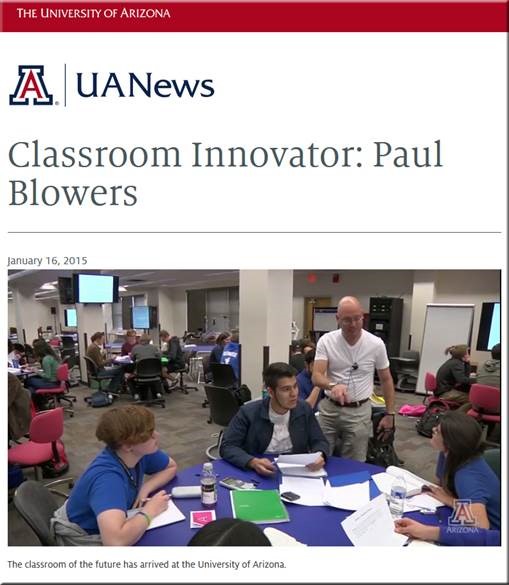Active Learning — from universitybusiness.co.uk by Rebecca Paddick
Excerpt:
Sean Corcorran, General Manager at Steelcase Education Solutions, discusses why it is important to make every space an ‘active learning environment’ and provides us with some guiding tenets on how to start reimagining the classroom space.
Pedagogy
- Design for quick transitions among multiple teaching modes: lecture, team, project, discussion, etc. from passive to active engagement
- Design for peer to peer learning
- Allow freedom of movement for the instructor, move away from the concept of the instructors space being fixed to the top of the class
Technology
- Design for sharing, take advantage of all spaces for display
- Explore new media, including personal and in-room technology
- Take careful consideration of all learning styles and abilities and the tools to suit these requirements
Space
- Give every student the best seat in the house by ensuring physical and visual access
- Design for quick ownership change, so classrooms adapt to changing users and varying class requirements
- Design for quick reconfiguration among multiple modes; from project work to test taking.
Learning spaces can morph from lecture mode to teamwork to group presentation and discussion, and back again. Every seat can be the best seat in the house. Technology can be integrated in smart ways so everyone can use it. Classrooms just need to be carefully planned so that the control is placed in the hands of the students and instructors.
Also see:
Steelcase Education Grant creates new opportunities in Ohio State classrooms – from thelantern.com by Stephanie Wise
Excerpts (emphasis DSC):
“We believe that the Active Learning Classroom will free the instructors from constraints imposed by static classrooms and allow students to move freely between different modes to collaborate with one another and enjoy the experience.”
…
“We have a lot of experience innovating in foreign language. One of the things we found that we liked best about the classroom is how it transforms your teaching practice,” Birckbichler said. “It is no longer a static classroom, but one that has maximum flexibility.”
As stated in the grant, the classroom allows for four modes: lecture, group, discussion and distance learning.
…
Bias said this is one of the best ways to help students reach their goals in the realm of language learning.
The new Active Learning Classroom is currently home to classes in film, foreign language, literature and culture.
…
“It totally transformed the way we look at how we teach…
Active learning classrooms enhance collaborative learning and inspire new approaches to teaching — from California State University Dominguez Hills by Paul Browning
Excerpts:
With the installation of three state-of-the-art active learning classrooms (ALC) this summer at California State University, Dominguez Hills (CSUDH) many students will experience a more collaborative and empowering way of learning, while faculty develop more creative approaches to teaching.
…
Although every instructor has a personal lecture style, students in an ALC will typically work first in groups of three on part of an assignment or an individual project, then combine with others into groups of nine and begin utilizing the tools in the classroom, such as the wall monitors and whiteboards to engage collaboratively in learning, according to Salhi.
…
“The instructors deliver lectures from the control center, but it’s more interactive then that,” said Salhi. “There is plenty of space for the students to interact, and for faculty to go around and examine their work. Each table has one student section leader, and the students get to grade themselves and grade their classmates, which encourages them to work harder on their projects. The students should always be an integral part of the learning and teaching process in the ALCs.”
UA professor dedicated to new teaching system — from wildcat.arizona.edu by Isaac Rounseville
Excerpt:
He and eight other faculty members from other science, technology, engineering and mathematics fields were part of a pilot program to initiate the Collaborating Learning Spaces Project.
The CLS project stems from a $500,000 grant the UA was rewarded by the AAU in the summer of 2013. It was one of eight other universities throughout the nation to receive the grant funding.
The project’s main goal is to expand more effective, evidence-based methods for teaching students the core knowledge of foundational science and engineering courses.
Some related items to this one include:
Addendum on 10/14/15:
- ‘Innovative Classrooms’ At Bronxville HS Successful Early On— from bronxville.dailyvoice.com
Excerpts:
EASTCHESTER, N.Y. – It’s still early on in the school year, but the initial returns regarding the trio of “innovative classrooms” at the Bronxville High School have been positive from students and teachers alike.Earlier this year, High School Principal Ann Meyer announced that the Board of Education agreed that three classrooms should be outfitted and redesigned to emphasize collaborative learning, rather than traditional, lecture-style lessons.According to the district, the “brand new learning spaces featuring state-of-the-art technology at the Bronxville High School are allowing students and teachers to move away from lecture formats toward more diverse students-directed learning experiences. The innovative spaces also provide an opportunity for student-to-student feedback and collaborative work.”
Addendum on 10/15/15:
Addendum on 10/20/15:
- Indiana U Formalizes Active Learning Efforts With ‘Mosaic’ Project — from campustechnology.com by Dian Schaffhauser; also see IU’s “Mosaic Active Learning Initiative”









